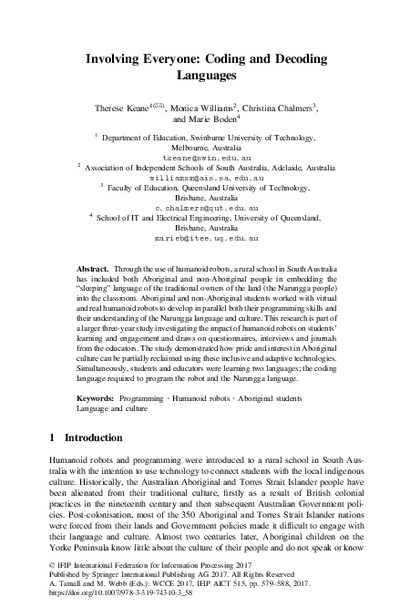Involving Everyone Coding and Decoding Languages
Therese Keane, Monica Williams, Christina Chalmers, Marie Boden
Zu finden in: Tomorrow's Learning: Involving Everyone. Learning with and about Technologies and Computing (Seite 579 bis 588), 2017
  |
 |
 Diese Seite wurde seit 3 Jahren inhaltlich nicht mehr aktualisiert.
Unter Umständen ist sie nicht mehr aktuell.
Diese Seite wurde seit 3 Jahren inhaltlich nicht mehr aktualisiert.
Unter Umständen ist sie nicht mehr aktuell.
 Zusammenfassungen
Zusammenfassungen
 Through the use of humanoid robots, a rural school in South Australia has included both Aboriginal and non-Aboriginal people in embedding the “sleeping” language of the traditional owners of the land (the Narungga people) into the classroom. Aboriginal and non-Aboriginal students worked with virtual and real humanoid robots to develop in parallel both their programming skills and their understanding of the Narungga language and culture. This research is part of a larger three-year study investigating the impact of humanoid robots on students’ learning and engagement and draws on questionnaires, interviews and journals from the educators. The study demonstrated how pride and interest in Aboriginal culture can be partially reclaimed using these inclusive and adaptive technologies. Simultaneously, students and educators were learning two languages; the coding language required to program the robot and the Narungga language.
Through the use of humanoid robots, a rural school in South Australia has included both Aboriginal and non-Aboriginal people in embedding the “sleeping” language of the traditional owners of the land (the Narungga people) into the classroom. Aboriginal and non-Aboriginal students worked with virtual and real humanoid robots to develop in parallel both their programming skills and their understanding of the Narungga language and culture. This research is part of a larger three-year study investigating the impact of humanoid robots on students’ learning and engagement and draws on questionnaires, interviews and journals from the educators. The study demonstrated how pride and interest in Aboriginal culture can be partially reclaimed using these inclusive and adaptive technologies. Simultaneously, students and educators were learning two languages; the coding language required to program the robot and the Narungga language. Dieses Kapitel erwähnt ...
Dieses Kapitel erwähnt ...
 Personen KB IB clear | Lew Semjonowitsch Vygotsky , Jeannette M. Wing | ||||||||||||||||||
 Begriffe KB IB clear |  Lernen Lernen learning
, learning
,  Programmieren Programmieren programming
, Zone of Proximal Development programming
, Zone of Proximal Development
| ||||||||||||||||||
 Bücher |
| ||||||||||||||||||
 Texte |
|
 Zitationsgraph
Zitationsgraph
 Zitationsgraph (Beta-Test mit vis.js)
Zitationsgraph (Beta-Test mit vis.js)
 Anderswo finden
Anderswo finden
 Volltext dieses Dokuments
Volltext dieses Dokuments
 |  Involving Everyone: Artikel als Volltext bei Springerlink ( Involving Everyone: Artikel als Volltext bei Springerlink ( : :  , 211 kByte; , 211 kByte;  : :  ) ) |
 Anderswo suchen
Anderswo suchen 
 Beat und dieses Kapitel
Beat und dieses Kapitel
Beat hat Dieses Kapitel während seiner Zeit am Institut für Medien und Schule (IMS) ins Biblionetz aufgenommen. Beat besitzt kein physisches, aber ein digitales Exemplar. Eine digitale Version ist auf dem Internet verfügbar (s.o.). Aufgrund der wenigen Einträge im Biblionetz scheint er es nicht wirklich gelesen zu haben. Es gibt bisher auch nur wenige Objekte im Biblionetz, die dieses Werk zitieren.










 Biblionetz-History
Biblionetz-History